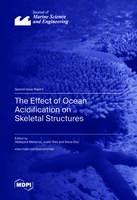Dublin Core
Title
The Effect of Ocean Acidification on Skeletal Structures
Subject
biomineralization; calcification; Mytilus edulis; Mytilus trossulus; predator-prey interactions; coral reefs; coral recruits; biomineralization; skeletal structure; synchrotron phase contrast-enhanced microCT; PCE-CT; artificial intelligence; ocean acidification; n/a; ocean acidification; ocean warming; echinoderm; starfish; mineralogy; skeleton; biomineralization; ocean acidification; freshwater acidification; freshwater calcifier; carbon dioxide; calcification; biomineralization; Lake Tahoe; Caribbean; coral; calcification; pH regulation; boron isotopes; B/Ca; carbon isotopes; photosynthesis; bleaching; symbiont; microelectrode; ocean acidification; global warming; calcifying fluid; scleractinian coral; zooxanthellate photosymbiont; photosynthesis; calcification; bleaching; phosphate; nutrient limitation; carbon dioxide; Archaean; Proterozoic; cyanobacteria; calcareous algae; coccolithophores
Description
The increasing partial pressure of atmospheric CO2 (pCO2) is reducing surface ocean pH, a process known as ocean acidification (OA) This results in a reduced saturation of the seawater with respect to the CaCO3 polymorphs aragonite, high-Mg calcite, and low-Mg calcite that are involved in the biological formation of calcareous skeletons and shells. The effect of OA on calcium carbonate precipitation and the subsequent dissolution in carbonate depositional systems, such as coral reefs, is a hotly debated topic. While early studies suggested that certain carbonate-secreting organism groups may be strongly affected by OA or may even become extinct, others observed highly variable, species-specific responses to OA, whereby some taxa are negatively affected, some are positively affected, and others are unaffected.
The collection of articles presented in this Special Issue presents ongoing research into the effects of OA on calcareous biomineralization while introducing some new questions and provocative hypotheses. The continued investigation of these concepts should advance our understanding of the mechanisms of biocalcification and improve predictions of how future CO2-induced changes in marine and freshwater systems will impact calcifying organisms, as well as the ecosystems they comprise, in the decades and centuries ahead.
The collection of articles presented in this Special Issue presents ongoing research into the effects of OA on calcareous biomineralization while introducing some new questions and provocative hypotheses. The continued investigation of these concepts should advance our understanding of the mechanisms of biocalcification and improve predictions of how future CO2-induced changes in marine and freshwater systems will impact calcifying organisms, as well as the ecosystems they comprise, in the decades and centuries ahead.
Creator
Hildegard Westphal (editor)
Justin Ries (editor)
Steve Doo (editor)
Justin Ries (editor)
Steve Doo (editor)
Source
https://www.mdpi.com/books/reprint/7652-the-effect-of-ocean-acidification-on-skeletal-structures
Publisher
MDPI - Multidisciplinary Digital Publishing Institute
Date
2023
Contributor
Jadik Wijayanto
Rights
© by the authors
Relation
https://mdpi-res.com/bookfiles/book/7652/The_Effect_of_Ocean_Acidification_on_Skeletal_Structures.pdf?v=1707844871
Format
PDF
Language
English
Type
Textbooks
Identifier
ISBN : 978-3-0365-8282-5 (Hardback)
ISBN : 978-3-0365-8283-2 (PDF)
DOI : https://doi.org/10.3390/books978-3-0365-8283-2
ISBN : 978-3-0365-8283-2 (PDF)
DOI : https://doi.org/10.3390/books978-3-0365-8283-2
Coverage
Basel, Switzerland, 2023

